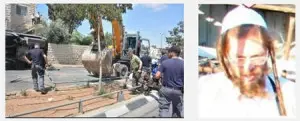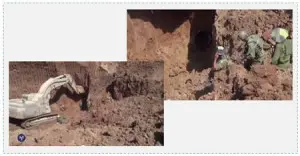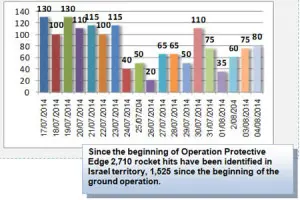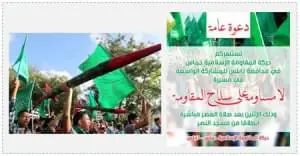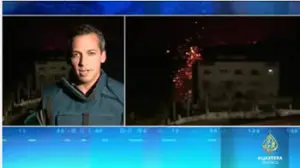Left: The site of the vehicular attack in Jerusalem (Police.gov.il, August 4, 2014)
Overview of the Situation
1. On August 5, 2014, a 72-hour ceasefire went into effect, initiated by Egypt and agreed to by Israel and Hamas. The IDF Spokesman reported that IDF forces were about to complete their withdrawal from the Gaza Strip and to redeploy along the border. He also reported that all the terrorist tunnels known to the IDF had been destroyed. Talks began in Cairo, attended by a Palestinian delegation, for arrangement. The Israeli media reported that an Israeli delegation is expected to leave for Cairo soon.
2. On August 4, 2014, the level of friction between the IDF and the terrorist organizations in the Gaza Strip declined, the result of the unilateral ceasefire declared by Israel. However, the terrorist organizations continued firing rockets and mortar shells into Israeli territory (80 rocket hits were identified on August 4). In addition, two terrorist attacks were carried out in Jerusalem (a vehicular attack and a shooting attack). A stabbing attack was carried out at the entrance to the city of Maale Adumim in Judea (east of Jerusalem) on August 5.
Terrorist Attacks in Jerusalem
Overview
3. On August 4, 2014, two terrorist attacks were carried out in Jerusalem: a vehicular attack involving a 360-degree excavator and a shooting attack. One Israeli civilian was killed and several were injured. An attack may have been prevented when an IDF force detained a Palestinian at the Hawara roadblock (south of Nablus). The Palestinian had three knives in his possession. An attack may also have been planned for Tel Aviv, and the police raised an alert and asked local residents to be wary (Walla.co.il, August 4, 2014).
Vehicular Attack in Jerusalem
4. In the early afternoon of August 4, 2014, a 360-degree excavator was driven off a building site in the center of Jerusalem by a Palestinian terrorist and used to run over a nearby pedestrian. The driver than used the excavator’s blade to overturn a bus. The bus was empty except for the driver and another employee of the company. The two sustained minor injuries and managed to leave the bus. A member of the Israel Prison Service shot and killed the terrorist, Muhammad Naif Jabis, from Jabal Mukaber. He had a criminal record and was known to the police.
5. The victim of the vehicular attack was an Orthodox Jew named Avraham Walles, 29, married and father of five, from the neighborhood of Mea Shearim in Jerusalem. He belonged to the Toldos Aharon Hasidic movement. Five other people were injured (not seriously) in the attack.
Left: The excavator used in the attack. Right: Avraham Walles, killed in the attack (Police.gov.il, August 4, 2014)
6. It was not the first time heavy construction equipment was used in Jerusalem for a vehicular attack. Such attacks are a familiar component of the so-called “non-violent” popular resistance, are relatively lethal and are generally carried out by lone terrorists. Between 2000 and 20008 approximately 20 vehicular attacks were carried out, killing 15 people. Conspicuous among them were three vehicular attacks in Jerusalem, two using heavy equipment, in which three people were killed and about 100 wounded (Israel Security Agency website, “Analysis of Attacks in the Last Decade”).[1]
7. Hamas spokesmen praised the attack and called for more of the same:
1) Hamas spokesman Fawzi Barhoum said that the attack was “a daring resistance act” and the natural reaction to Israel’s actions in the Gaza Strip. He called for the increase of all forms of “resistance” [i.e., violence and terrorism] throughout Palestine (Alresala.net, August 4, 2014). In a recent interview, Fawzi Barhoum called on the residents of Judea and Samaria to overcome their political disagreements, declare a “struggle,” take their vehicles and “run over Jews and kill scores of Zionists” (Alquds.com, July 30, 2014).
2) Hamas spokesman Husam Badran praised the “heroic act.” He said it was the natural response to Israel’s [so-called] “crimes” in the Gaza Strip, which authorized the Palestinians to respond with the means they had at their disposal. He said that in Jerusalem, Judea and Samaria there was room for more such acts (Al-Aqsa TV, August 4, 2014).
Shooting Attack on Mt. Scopus
8. On the afternoon of August 4 a man dressed in black shot a soldier waiting at a bus stop near the Mt. Scopus tunnel. A security guard near the soldier tried to shoot back but the terrorist escaped on a motorcycle. Police forces tried to locate him but so far have not been successful. The soldier, shot in the stomach, was critically wounded and evacuated to a hospital.
IDF Activity
IDF Activity in View of the Ceasefire
9. On the evening of August 4, 2014, Major General Sammy Turgeman, commander of the Southern Command, announced that the task of destroying the tunnels extending into Israeli territory would soon come to an end. He said that most of the tunnels known to the IDF had been destroyed, including those exposed during the ground operation (IDF Spokesman, August 4, 2014).
10. Later the same evening it was reported that Israel had accepted the Egyptian proposal for a 72-hour, unconditional ceasefire in the Gaza Strip, beginning on August 5 at 0800 hours. It was also reported that in the near future an Israeli delegation would leave for Cairo for talks for a long-term, stable ceasefire.
11. Brigadier General Motti Almozannounced that the IDF would soon complete its withdrawal from the Gaza Strip and redeploy along the border. He said the withdrawal was not a condition for a ceasefire but an Israeli decision made on the basis of operational considerations (IDF Spokesman, August 5, 2014).
12. At 0800 hours on August 5, after 29 days of Operation Protective Edge, and after the IDF announced that all the known terrorist tunnels had been destroyed, the ceasefire went into effect. A few minutes before 0800 hours Israel was attacked by a heavy barrage of rocket fire. So far, the ceasefire is still in force.
Israel’s Unilateral Humanitarian Ceasefire
13. On August 4, 2014, Israel unilaterally announced a seven-hour humanitarian ceasefire between the hours of 1000 and 17000. The ceasefire was not honored by the terrorist organizations in the Gaza Strip. While there were fewer clashes between IDF forces and terrorist operatives, throughout the day rocket and mortar shell fire continued targeting Israeli territory. The IDF continued destroying terrorist tunnels.
14. The security forces of the terrorist organizations warned Gazans not to be drawn in by Israeli announcements about a ceasefire and not to be less careful because of Israel’s “deception” (Paltoday.ps, August 5, 2014).
Destroying the last tunnel (IDF Spokesman, August 4, 2014) Click watch?v=kBW6oR_dpVI for the video.
Air Attacks on Terrorist Targets
15. During the past 24 hours, until the ceasefire went into effect, Israeli Air Force (IAF) aircraft continued attacking terrorist targets from the air. Since the beginning of Operation Protective Edge about 4,720 terrorist targets in the Gaza Strip have been attacked.
IDF and Civilian Losses
16. Sixty-four IDF soldiers and three civilians have been killed in Operation Protective Edge. Ninety-seven soldiers are still hospitalized, nine of them in critical condition.
Rocket Fire into Israeli Territory
17. Since the beginning of the operation approximately 2,710 rockets have hit Israeli territory, 1,525 since the beginning of the ground operation. The Iron Dome aerial defense system intercepted about 570 of them. During the IDF’s withdrawal from the Gaza Strip and redeployment, the scope of rocket and mortar shell fire into Israel again increased.
18. On August 4, 2014, 80 rocket hits were identified in Israeli territory. Most of the rockets fell in the communities near the Gaza Strip and in the western Negev. In addition, several dozen mortar shells were fired at the communities near the Gaza Strip and at the IDF forces deployed along the border. An IDF soldier sustained minor shrapnel wounds from a mortar shell.
19. On the morning of August 5, 2014, a few minutes before the ceasefire went into effect, a barrage of rockets was fired into Israel. About 20 rockets were launched at the communities around the Gaza Strip, Ashdod, Ashqelon, Kiryat Malachi, Gan Yavne, Maale Adumim, Rishon Letzion and Rehovot. Rocket fragments were found in the heart of Jerusalem and a building in Beit Sahour, near Bethlehem, was hit. Hamas’ military-terrorist wing issued a statement claiming responsibility for the rocket fire on August 5, minutes before the ceasefire began.
Daily Distribution of Rocket Hits in Israeli Territory during Operation Protective Edge[2]
The Gazan Population
20. According to ITIC information,1,552 Gazans have been killed since the beginning of the operation (as of noon, August 5).
21. The distribution (not final, as of noon, August 4, 2014) of the 1,552 Palestinians killed is as follows:
1) 467 terrorist operatives:
A. 254 Hamas operatives
B. 147 PIJ operatives
C. 66 operatives from other terrorist organizations
2) 480 non-involved Palestinians
3) 605 Palestinians whose identity is not yet known
The Humanitarian Situation in the Gaza Strip
22. Reports from the Gaza Strip indicate that the humanitarian situation continues to deteriorate. According to a UNOCHA (United Nations Office for the Coordination of Humanitarian Affairs) report, about 485,000 Gazans have been displaced, approximately 27% of the population. About 260,000 Gazans have found shelter in 90 UNRWA schools. UNRWA reported difficulties with supplies of food, water, and sanitation and cleaning materials for Gazans sheltered in their schools. It was also reported that the cost of rebuilding the schools and the houses of Gazans destroyed in the operation was estimated at $380 million (UNRWA.org, August 3, 2014).
23. Mufid al-Hasayneh, minister of public works and housing in the national consensus government, claimed that rebuilding the Gaza Strip could be expected to reach $5 billion. He claimed that 10,000 houses had been completely destroyed and 30,000 had been damaged. The infrastructure had been damaged, including the water and sewage systems, as well as government buildings, mosques, police stations, diesel fuel tanks used by the power plant, etc. (Maannews.net, August 4, 2014). Jawad Awad, minister of health in the national consensus government, met with a Red Cross delegation and demanded it continue its activities in the Gaza Strip and that it protect the Gazans. He also asked that the Red Cross answer the complaints of Gazans regarding the slowness of its response to their calls for help (Aa.com.tr, August 4, 2014).
24. Given the difficult humanitarian situation, aid convoys and shipments are being organized for the Gaza Strip, among them the following:
1) The Palestinian Authority (PA) representative in South Africareported that a medical delegation was being organized which would include 39 doctors, male nurses and orderlies, as well as media personnel. The delegation would bring medical equipment for three hospitals (Maannews.net, August 4, 2014).
2) A plane from Italyis supposed to land in Israel bringing tents, blankets, batteries, containers of water and medicines. The material will enter the Gaza Strip through Israel (Wafa.ps, August 4, 2014).
The Crossings – Update
The Erez Crossing
25. So far 50 Palestinians have received medical treatment at the field hospital Israel erected at the crossing. Hamas continues to prevent Gazans from reaching the crossing for treatment.
The Kerem Shalom Crossing
26. Since the beginning of Operation Protective Edge 1,737 trucks have entered the Gaza Strip through the crossingcarrying food, medical equipment, diesel fuel for the power plant, gasoline for transportation and cooking gas (Cogat.idf.il, August 4, 2014).
The Rafah Crossing
27. Close sources reported that Egyptian President Abdel Fattah el-Sisi objected to any attempt to include the opening of the Rafah crossing in the negotiations. He also objects to any international management of the crossing or any attempt to force Egypt to open it at specific times. He requested that the discussion about opening the crossing be postponed until after the negotiations had ended. Regarding the ceasefire he said that only Egypt and the PA would coordinate the issue (Al-Akhbar.com, August 4, 2014).
Judea and Samaria
28. Calls continue to be heard in Judea and Samaria for Palestinians to demonstrate and hold events in support of the Gaza Strip. The Islamic Bloc of Al-Najah University in Nablus posted an invitation on its Facebook page asking people to come to a demonstration in support of the Gazans on August 4, 2014. The invitation was issued by Hamas under the heading “No bargaining over the weapon of the resistance.” Many Palestinians attended the demonstration, where green Hamas-affiliated flags were waved and models of rockets were carried (Facebook page of the Islamic Bloc of Al-Najah University, August 4, 2014).
Left: Demonstrators carry green Hamas-affiliated flags and models of rockets. Right: The invitation to the demonstration (Facebook page of the Islamic Bloc of Al-Najah University, August 4, 2014)
Contacts for a Ceasefire
29. Egypt appealed to Israel, the PA and all the Palestinian terrorist organizations to agree to a 72-hour ceasefire, which could be extended. The ceasefire went into effect at 0800 hours on August 5, 2014. While it is in effect high-level delegations from both sides will meet to implement the Egyptian initiative (MENA.org.eg, August 4, 2014).
30. Israelaccepted the Egyptian initiative for a ceasefire. Cabinet members were informed of the prime minister’s decision to accept the proposal. It was also reported that in the near future an Israeli delegation would leave for Cairo for talks for a long-term, stable ceasefire.
31. Azzam al-Ahmad, a member of the PLO’s Central Committee who heads the Palestinian delegation to Egypt, claimed the Palestinian delegation had agreed to a ceasefire but stressed that there would be no direct negotiations between the Israeli and Palestinian delegations (Wafa.ps, August 4, 2014). He reported that Egypt had formulated a two-part proposal: a 72-hour ceasefire and the cessation of all military activity, after which a permanent ceasefire would be reached (Palestinian TV, August 4, 2014). Regarding the disarmament of the Gaza Strip, Azzam al-Ahmad claimed that Mahmoud Abbas had made it particularly clear to John Kerry that the issue of disarming the Palestinians in the Gaza Strip was out of the question and that the Palestinians would never agree to it (Al-Jazeera, August 4, 2014).
32. Hamas and the Palestinian Islamic Jihad (PIJ) responded as follows:
1) Senior Hamas figure Izzat al-Rishq reported that Hamas had agreed to a 72-hour ceasefire. He said that while it was in effect indirect negotiations would take place in Cairo regarding the terms of a lull. It would be based on the demands the Palestinian delegation had presented to Egypt (Facebook page of Izzat al-Rishq, August 5, 2014).
2) Hamas spokesman Sami Abu Zuhri said the Hamas document included “the cessation of all forms of aggression towards the Gaza Strip” and the lifting of the [so-called Israeli] siege. He claimed the precondition for the ceasefire was the withdrawal of all the Israeli forces from the Gaza Strip (Al-Aqsa TV, August 5, 2014).
3) Ziyad al-Nakhaleh, deputy PIJ secretary general, claimed the ceasefire met the demands of the Palestinian people, which were an end to Israeli aggression and the lifting of the siege. He claimed Egypt understood the Palestinians’ demands and had agreed to them (Paltoday.ps, August 4, 2014).
The Propaganda and Legal Campaign
Promoting Legal Procedures
33. Saeb Erekat, a member of the PLO’s Executive Committee, claimed he had begun consulting with legal experts in preparation for the PA’s appealing to the International Criminal Court (ICC) in The Hague. He claimed he would arrive in London in the near future to discuss the matter. He claimed he was still waiting for a response from Hamas and the PIJ regarding their signing a document authorizing Mahmoud Abbas to join the Rome Convention (Palestinian TV, August 4, 2014). The PA is postponing its appeal to the ICC until it receives formal authorization from Hamas and the PIJ out of concern that an appeal to the ICC will expose the terrorist organizations in the Gaza Strip to suits.
34. However, Hamas spokesman Musheir al-Masri claimed not to understand the excuse Mahmoud Abbas was using to avoid appealing to the ICC. He said Mahmoud Abbas had every possibility of doing so in view of the proof he had. He claimed that Hamas had encouraged and pushed the PA to appeal to the ICC and that no delay was justified (Al-Aqsa, August 4, 2014).
Calls to Remove the Al-Jazeera Correspondent from the Gaza Strip
35. Social network activists called for the expulsion of Nick Schifrin, Al-Jazeera’s correspondent in English, from the Gaza Strip because of what they called his “unprofessional coverage of the events.” They claimed his coverage was biased toward Israel and that he had adopted Israel’s position towards the attacks on Gaza. They also claimed that his reporting had revealed the location of rocket launching sites (Palpress.ps, August 4, 2014). On July 31, 2014, Schifrin, who serves as the Al-Jazeera director in Jerusalem, reported that a building near his hotel was attacked immediately after he finished his report. He also said that rockets had been fired an estimated 80-100 meters (or about 88-110 yards) from the building, and that showed how close rocket launchers were to residential neighborhoods.
The report by Nick Schifrin about a rocket launched near his hotel. Right: The site attacked by the IDF.
http://america.aljazeera.com/watch/shows/live-news/2014/7/a-strike-in-gazacomesdangerouslyclosetoaljazeerareporter.html for the video.
NOTES
[1]For further information see the October 22, 2013 ITIC bulletin “Vehicular Attacks: Modus Operandi Considered by the Palestinians as Part of the Popular Resistance in Judea and Samaria.”
[2]The graph indicates rocket hits in Israeli territory and does to include the massive mortar shell fire into the western Negev or rocket launches that failed.
* This report was originally published on August 8 on the Meir Amit website under the title “Operation Protective Edge – Update No. 20 (As of 1200 hours, August 5, 2014)”.

